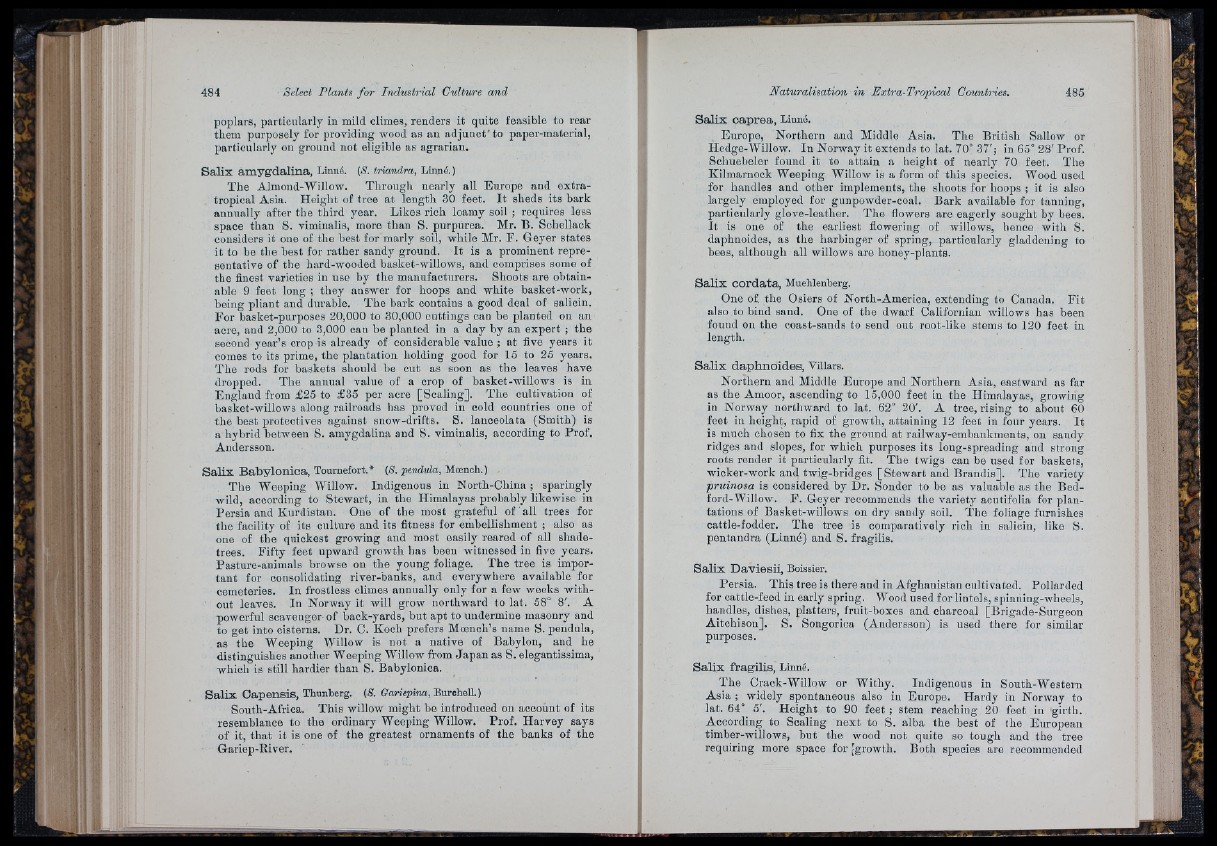
poplars, particularly lu mild climes, renders it quite feasible to rear
them purposely for providing wood as an a d ju n c t'to paper-material,
particularly on ground not eligible as agrarian.
Salix amygdalina, Linné. (S. triandra, Linné.)
The Almond-Willow. Througli nearly all Europe and extra-
tropioal Asia. Height of tree at length 30 feet. I t sheds its bark
annually after the third year. Likes rich loamy soil ; requires less
space than S. viminalis, more than S. purpùrea. Mr. B. Schellack
considers it one of the best for marly soil, while Mr. F. Geyer states
it to be the best for rather sandy ground. It is a prominent representative
of the hard-wooded basket-willows, and comprises some of
the finest varieties in use by the manufacturers. Shoots are obtainable
9 feet long ; they answer for hoops and white basket-work,
being pliant and durable. The bark contains a good deal of salicin.
For basket-purposes 20,000 to 30,000 cuttings can be planted on an
acre, and 2,000 to 3,000 can be planted in a day by an expert ; the
second year’s crop is already of considerable value ; at five years it
comes to its prime, the plantation holding good for 15 to 25 years.
The rods for baskets should be cut as soon as the leaves have
dropped. The annual value of a crop of basket-willows is in
England from £25 to £35 per acre [Scaling]. The cultivation of
basket-willows along railroads has proved in cold countries one of
the best protectives against snow-drifts. S. lanceolata (Smith) is
a hybrid between S. amygdalina and S. viminalis, according to Prof.
Andersson.
Salix Babylonica, Tournefort.* {S. pendula, Moench.)
The Weeping Willow. Indigenous in North-China ; sparingly
wild, according to Stewart, in the Himalayas probably likewise in
Persia and Kurdistan. One of the most grateful of ' all trees for
the facility of its culture and its fitness for embellishment ; also as
one of the quickest growing and most easily reared of all shade-
trees. Fifty feet upward growth has been witnessed in five years.
Pasture-animals browse on the young foliage. The tree is important
for consolidating river-banks, and everywhere available for
cemeteries. In frostless climes annually only for a few weeks without
leaves. In Norway it will grow northward to lat. 58° 8'. A
powerful scavenger of back-yards, but apt to undermine masonry aud
to get into cisterns. Dr. C. Koch prefers Moencii’s name S. pendula,
as the Weeping Willow is not a native of Babylon, and he
distinguishes another Weeping Willow from Jap an as S. elegantissima,
which is still hardier than S. Babylonica.
S a lix C ap en sis, Thunberg. (S’. Ganepiîioe, Burchell.)
South-Africa. This willow might be introduced on account of its
resemblance to the ordinary Weeping Willow. Prof. Harvey says
of it, th a t it is one of the greatest ornaments of the hanks of the
Gariep-Eiver.
Sadix caprea, Linné.
Europe, Northern and Middle Asia. The British Sallow or
Hedge-Willow. In Norway it extends to lat. 70° 37'; in 65° 2 8 'Prof.
Schuebeler found it to attain a height of nearly 70 feet. The
Kilmarnock Weeping Willow is a form of this species. Wood used
for handles and other implements, the shoots for hoops ; it is also
largely employed for gunpowder-coal. Bark available for tanning,
particularly glove-leather. The flowers are eagerly sought by bees.
It is one of the earliest flowering of willows, lienee with S.
daphnoides, as the harbinger of spring, particularly gladdening to
bees, although all willows are honey-plants.
Salix oordata, Muehlenberg.
One of the Osiers of North-America, extending to Canada. F it
also to bind sand. One of the dwarf Californian willows has been
found on the coast-sands to send out root-like stems to 120 feet in
length.
Salix daphnoides, Villars.
Northern and Middle Europe and Northern Asia, eastward as far
as the Amoor, ascending to 15,000 feet in the Himalayas, growing
in Norway northward to lat. 62° 20'. A tree, rising to about 60
feet in height, rapid of growth, attaining 12 feet in four years. I t
is much chosen to fix the ground at railway-embankments, on sandy
ridges and slopes, for which purposes its long-spreading and strong
roots render it particularly fit. The twigs can be used for baskets,
wicker-work and twig-hridges [Stewart and Brandis]. The variety
-pruinosa is considered by Dr. Sonder to be as valuable as the Bed-
ford-Willow. F. Geyer recommends the variety acutifolia for plantations
of Basket-willows on dry sandy soil. The foliage furnishes
cattle-fodder. The tree is comparatively rich in salicin, like S.
pentandra (Linné) and S. fragilis.
Salix Daviesii, Boissier.
Persia. This tree is there and in Afghanistan cultivated. Pollarded
for cattle-feed in early spring. Wood used for lintels, spinning-wheels,
handles, dishes, platters, fruit-boxes and charcoal [Brigade-Surgeon
Aitchison]. S. Songorica (Andersson) is used there for similar
purposes.
Salix fragilis, Linné.
The Craok-Willow or Withy. Indigenous in South-Western
Asia ; widely spontaneous also in Europe. Hardy in Norway to
lat. 64° 5'. Height to 90 feet ; stem reaching 20 feet in girth.
According to Scaling next to S. alba the best of the European
timber-willows, hut the wood not quite so tough and the tree
requiring more space for [growth. Both species are recommended